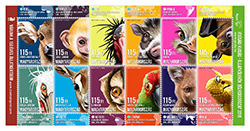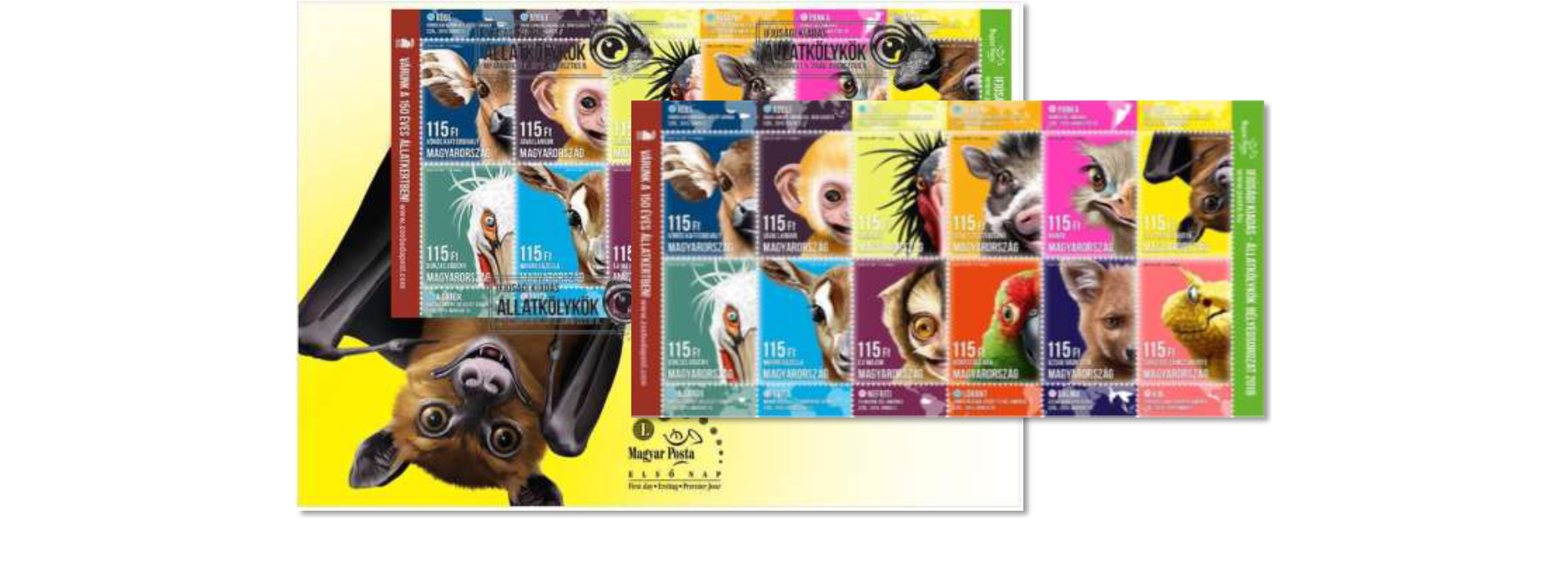The 150-YEAR-old Budapest Zoo
The stamps are available in our webshop as well.
Magyar Posta is issuing a special small stamp sheet entitled Animal Cubs II featuring twelve young residents of the Budapest Zoo and Botanical Garden. The following cubs can be seen in the stamp designs: Rudi, the African forest buffalo, Adolf, the Javan surili, Öcsi, the northern bald ibis, Bulan, the Visayan warty pig, Panka, the greater rhea, Batty, a Lyle's flying fox, Gátőr (dam guard), the Dalmatian pelican, Evita, the mhorr gazelle, Nefriti, the night monkey, Lóránt, the red-fronted macaw, Dalma, the dhole, and Kia, the eyelash viper. The edge of the sheet contains the given cub's name, the colour sign indicating its gender, the name and original habitat of the species, and the cub's date of birth. A map section can be seen on the base print. The small stamp sheet worded in a lively tone and issued in 2014 as a continuation of the small stamp sheet entitled Animal Cubs was also produced by Pénzjegynyomda Zrt., based on the plans by Tibor Zoltán Petényi. The new products are available from 9 August at first day cover post offices and at Filaposta, and they can also be ordered from Magyar Posta's webshop.
 The
uniquely astounding listed site of the former Zoo of Pest, which is called the
Budapest Zoo and Botanical Garden today and is celebrating the 150th
anniversary of its foundation in 2016, welcomes visitors in Városliget - the City Park - situated in the heart of the
capital city of Hungary. Opened on 9 August 1866, it is among the world's
oldest zoos. In those days visitors could admire 500 animals in the zoo, while
now about 10,500 animals of over one thousand species can be seen here. The
stock is expanding continuously and gradually, providing a rich overview of the
biodiversity living on Earth. Due to the large number of animals, the
collection is remarkable even in international comparison. Besides mammalsand
birds, which
are the most popular among the visitors, a multitude of different reptiles,
amphibians, fish and invertebrates can be seen here.The past eighteen months
can be regarded as a lucky period again from the aspect of a new generation of
animals. Population growth took place in the case of numerous species. Some of
the most significant results: the kangaroo family has six new members; a wombat
emerged again from its mother's pouch; there are seven young cubs in the pack
of dholes; and five piglets have been added to the family of the critically
endangered Visayan warty pigs - all this to the greatest pleasure of the staff
and visitors of the Zoo.
The
uniquely astounding listed site of the former Zoo of Pest, which is called the
Budapest Zoo and Botanical Garden today and is celebrating the 150th
anniversary of its foundation in 2016, welcomes visitors in Városliget - the City Park - situated in the heart of the
capital city of Hungary. Opened on 9 August 1866, it is among the world's
oldest zoos. In those days visitors could admire 500 animals in the zoo, while
now about 10,500 animals of over one thousand species can be seen here. The
stock is expanding continuously and gradually, providing a rich overview of the
biodiversity living on Earth. Due to the large number of animals, the
collection is remarkable even in international comparison. Besides mammalsand
birds, which
are the most popular among the visitors, a multitude of different reptiles,
amphibians, fish and invertebrates can be seen here.The past eighteen months
can be regarded as a lucky period again from the aspect of a new generation of
animals. Population growth took place in the case of numerous species. Some of
the most significant results: the kangaroo family has six new members; a wombat
emerged again from its mother's pouch; there are seven young cubs in the pack
of dholes; and five piglets have been added to the family of the critically
endangered Visayan warty pigs - all this to the greatest pleasure of the staff
and visitors of the Zoo.
Source: budapestzoo.com



